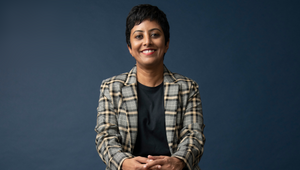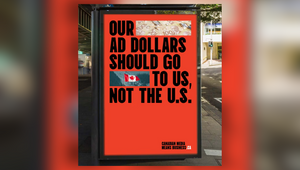
Creating Imperfectly Perfect VFX: Wonky, Quirky Realism

There’s a time and place for glossy, flawless effects that draw a viewer in, and then there’s also the need for quirky, wonky and realistic touches in more realistic settings. In the visual effects world, the two live simultaneously together, as artists work hard to represent life’s perfectly imperfect moments when creating content.
While speaking to specialists in the VFX community, it became apparent that the key to creating successful effects lies in the finely tuned balance of being seemingly invisible. If as an audience, we look at a piece and question the visual effect techniques, how they came together and where reality ends and computer-generated aspects begin, the artist behind the work hasn’t quite achieved that seamlessness. “If we do our job right, no one will know. If we don't do it right, everyone will,” explains Framestore’s head of CG, Johannes Sambs.
Speaking on the tech that supports this balance, 9iFX’s 3D lead Eric Reed says, “Combining the artistry of the human touch with the capabilities of ever-evolving technology, VFX specialists are achieving new heights of realism while keeping the magic of imperfection alive on the silver screen.” But there are also other elements to consider, which is why LBB reached out to VFX specialists across the industry.
We posed two questions to each artist, the first asked about how and why imperfections are added, and the other about the tech which is bringing this realism to the forefront. Here’s what the experts had to say in response.
Johannes Sambs
Head of CG at Framestore London, (advertising, episodic, and immersive)
The goal and arguably pinnacle of successful photoreal VFX is creating the illusion that the digital work never happened. The successful deception is that whatever is seen on screen simply exists and the outcome is that the audience never questions what it sees. These are among the highest praises for any VFX artist. And, paradoxically, at the same time a source of misunderstanding of what VFX artists actually do: if we do our job right, no one will know. If we don't do it right, everyone will.
So what makes things look and feel real? The key lies in imperfection. Photoreal VFX is trying to emulate the real world, using ‘reality’ as a blueprint or reference to create an illusion of reality. What makes a forest look like a forest, a dog like a dog, a human like a human and a sunset like a sunset? The common denominator is the infinite amount of variation, detail and imperfection.
When creating a whole underwater world for a Sheba campaign, lemurs, polar bears and snakes for ‘His Dark Materials’ or Buckingham Palace for 'The Crown’, the goal was to do justice to the chaos and visual depth of every coral, hair and brick. Magnify a pin-head and you will find layers upon layers of complexity. Look at each hair on your head and no two will be alike.
There are tools that help us on the journey, facilitating the creation of manufactured perfection and consistency and paving the way for the final human touches. Procedural approaches through software like Houdini allow us to create systems that can evolve naturalistically rather than create single-purpose solutions and the integration of AI tools in packages like Nuke can speed up potentially repetitive and menial tasks.
Yet, adding life and a sense of reality through imperfection and achieving true photorealism comes from the artist’s understanding of the world and how it looks and behaves when it is being captured through a camera. If it’s done right, you’ll never know it was us.
Julian van Mil
Creative director at Feather
The way we make a shot look real is by 'dirtying up the lens’. In its simplest form, it adds things like diffusion, grain, distortion, halation, and aberrations, but there's a fine line between making a shot believable and degrading the image quality. You have to be really artful and intentional with your application of these elements.
For example, a few years ago, we did a test shoot at Feather where we rented a lens kit and shot some flashlights at bracketed exposures through the lens, creating really high-range lens kernel images. We can use these seemingly random-looking images to 'profile' the characteristics of an actual lens and how it affects light.
We then use this image as a kernel for a convolution, and we get a very subtle blur over the image that gracefully softens it. All this for a one or two-pixel blur… but it's more than a blur. It has the life of a physical lens, and it takes the CG ‘stink’ off of images in an organic way that’s just more interesting and has some soul. These details make the difference.
I think the obvious answer to tech advances comes in the form of AI diffusion models. While there was a lot of industry fear about ‘taking our jobs’, as these models spread and gained adoption, I believe we're quickly seeing that they're simply a very useful tool in our arsenal that allows us to iterate, build new images and tell new stories at new speeds previously thought impossible and with unprecedented realism.
Grant Miller
Executive VFX supervisor at Ingenuity Studios
The realism of a shot really begins with the various buildings, props, etc. that make up that scene. CG artists tend to create the perfect version of almost anything, be it a table, desk, or skyscraper. In the real world, nearly all these objects are tweaked or bent because they're crafted and assembled by error-prone humans.
One of the most frequent notes I give as a VFX Supervisor is to ‘funk up the model a bit’, which we often do procedurally to keep the original clean and pristine. The subtle variation on each window of a skyscraper is what sells the realism. It's immediately obvious when those considerations aren't being taken at the asset level, but once you get those things in place the shots can really sing.
When it comes to tech, we're rapidly integrating AI into many of our processes, and really see it speeding up and elevating our work as a studio. We're particularly excited about a tool we're working on that allows us to recolour renders to match an existing reference. The perfect hue of brick or the correct saturation of moss can be challenging and time-consuming to achieve, particularly in harmony with a larger scene. With AI-powered tools, we're able to match a scene's colour palette to filmed footage quicker and more naturally than we would have time to do by hand, allowing artists to focus on adding additional details instead of tweaking colours.
Libby Orett & Hugo Rosado
VFX producer and VFX supervisor at Creep
It’s about using human experience to question and challenge everything. When we approach any VFX shot, we always aim to start with best practice processes and total accuracy. The attention to detail in any 2D or 3D design, roto, tracking etc, has to be technically perfect, and then it’s usually through the compositing that we bring the human touch, to make the work believable.
On ‘Top Boy’, this was creating 3D construction hoarding to exactly match the practical versions, but then weathering each one to seamlessly embed them into the different shots. On ‘Sex Education’, when replacing the brickwork on the buildings, we used randomisation techniques to ensure there was no obvious tiling or repeating of any imperfections we had added – things that the viewer would instantly pick up on.

There's no doubt the constant updates in software make a big impact on our process – the incorporation of AI is making the tools smarter, taking over a lot of heavy lifting and making it possible for the VFX artist to have more time to invest in the creativity and focus on the realism that needs to be curated by the human touch.
On a recent project where we had to replace some human heads, we used Blender Human Generator to do a lot of the heavy lifting for generating the CG characters. Whilst we refined all features and embedded them with compositing, some of the textures, wrinkles, blemishes and hair that Blender Human could add in a matter of minutes, would have taken a human artist days. It’s all about harnessing the power of the tools.
Eric Reed
3D lead at 9iFX Studios
In the world of VFX, embracing imperfections and infusing them into the digital realm is a growing trend. By combining the artistry of the human touch with the capabilities of ever-evolving technology, VFX specialists are achieving new heights of realism while keeping the magic of imperfection alive on the silver screen. Tools and technology have come a long way in helping artists like me achieve that perfectly imperfect look. High-resolution 3D scanning and photogrammetry allow VFX professionals to capture real-world elements with all their quirks, such as the rough texture of aged wood or the intricate details of a weathered stone wall. These scans serve as invaluable references to add an authentic touch to CG elements.
For example, in our recent project for footwear company Danner, I deliberately introduced subtle flaws through the use of noise and grunge textures in normal and displacement maps. These imperfections created tiny irregularities in the surfaces, slight distortions in the lighting, and even changed the silhouette of an object. For instance, I try to never have a truly straight line.
I also believe the single greatest advancement in VFX technology lies in GPU rendering. Biassed GPU render engines like Redshift allow for high-end rendering effects like global illumination, depth of field, and motion blur to be rendered directly. We used this technology to our benefit in the Danner project, and it really made an impact for quick iterations in our study of different forms of aged leather.

Jonas Drehn
VFX supervisor and co-founder at BaconX
‘Perfect' is an open-ended concept. It varies based on the storytelling and content we create. In many cases, we strive to recreate reality and achieve invisible effects. However, the goal is also to craft artistic and engaging images, which means knowing when to deviate from reality.
At BaconX, we're renowned for our 'invisible' VFX work. In fact, some clients have even inquired about our CG capabilities, as they couldn't discern it from our showreel, despite featuring a lot of CG work. We've tackled several projects involving realistic creatures behaving in unusual ways. This is where introducing chaos and imperfections becomes crucial for maintaining believability and avoiding the 'fake CG' look. One notable example is an older VW spot featuring laughing horses, where we blended real horses with CG to capture the randomness and nuance of real horse movements.
Mixing real and CG remains a top choice for incorporating imperfections because it builds upon something genuine. In recent projects with full-CG creatures, we've adopted advanced tools like skeletons and muscle simulations. This approach mimics nature's principles and introduces subtle deformations and movements that might go unnoticed but make everything look more accurate and real.
Having advanced technical tools or not, our way of bringing reality to CG images has always been to study the real behaviour of movements, lights, and materials and spend the effort and time needed to implement that into the work.
With CG tools evolving rapidly, providing continuous upgrades and new tech developments that enhance realism. We keep our pipeline adaptable to employ the best tools for specific tasks. One classic yet effective technique that endures is the VFX mirror ball, which has been used in the industry for decades to capture real light on set and apply it to illuminate CG scenes. Nowadays, this practice involves off-the-shelf 360-degree cameras.
In terms of recent technology, CG capture and scanning of objects, locations, and materials have been transformative for complex projects. This transformation is set to intensify with the integration of machine learning and AI in the coming years.
Cody Amos
Creative director at Heckler
Imperfections really are key to making convincing VFX. The real world comes with plenty of texture and detail and rough edges that you don’t really even notice. This is why if you shoot something for real, you’re likely to spend a while online ‘cleaning up’ the real world to make it a little tidier. But when you make something in CG, you’re starting at the opposite end of the spectrum, so you spend a lot of time adding a little chaos to everything.
Glass needs fingerprints added, concrete needs to be cracked, and lights need to go through something to mess them up a little. The list goes on. Beauty is in the imperfections. It’s like music. A perfect note on a synthesiser sounds digital and fake, but when you mess it up in the right way, perhaps by playing the note with strings and letting the sound reverberate in a wooden chamber, like a piano or guitar, it sounds rich and beautiful. Adding all that texture to everything in CG is like trying to get the image to reverberate in the chamber of the real world.
When it comes to simulations, a lot of what artists do is try to get the right amount of chaos into the motion of the water or the smoke or the cloth, so that it feels natural. I was an FX artist on ‘The Hunger Games’, and the best explosions I did on that project were the ones that were a bit lopsided, like most of the force went in a direction you weren’t expecting.
At Heckler, we recently did a project for Grab where we built the worlds out of paper and used popsicle sticks to puppeteer things. Of course, it was all CG, so every imperfection is placed by an artist, from the cardboard edges to the sticky tape keeping things together.
In visual effects, the amazing part is that we can control every little thing. The really difficult part is that we have to control every little thing.
Jordi Bares & Josh King
Founder and head of production and sustainability at Rohtau
In the world of visual effects, our mission is to craft seamless, believable visuals that transport audiences into compelling narratives. But here's the challenge: the real world isn't perfect. To truly immerse audiences in a story, we must embrace its beautifully imperfect reality.
Consider this: there are no perfectly straight lines or flawless surfaces in the real world. Light dances across materials in intricate patterns, each with its unique signature. Objects bear the marks of their creation, manufacturing, and usage. Is that surface polished, sand-blasted, coated, or treated in some mystical way? The complexity is astounding.
Take, for instance, our work on LEGO. We embarked on a journey to infuse every brick with a tangible authenticity that resonates with audiences.
Our quest for authenticity took us on a journey into detail:
- Geometry detail: To mirror reality, our objects couldn't have perfect lines or pristine surfaces. We added dents, scuffs, and those charming usage imperfections that subtly alter the surface. We even brought laser-scanning and expert sculptors into the mix.
- Texture detail: The world ages, and so do objects. We introduced different colourations inspired by aged plastics, an array of scratches, fingerprints, grease, and dust. We meticulously layered these textures to evoke a sense of scale and history.
- Material detail: For objects deeply ingrained in our everyday lives, we obsessively chased the play of light on their surfaces.
- Lighting detail: Lighting isn't just about illumination; it's about the subtle nuances it imparts.
The pursuit of hyper-realism is relentless, driving us to harness cutting-edge technology. A robust infrastructure and a streamlined pipeline are non-negotiable. In this intricate dance of detail and authenticity, the process reigns supreme. We meticulously chart timelines with defined milestones. In this way, our commitment to the process ensures we hit the high notes in our quest to create perfectly imperfect VFX.















